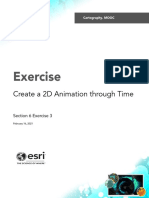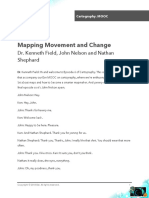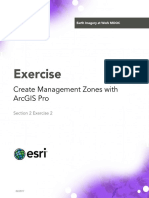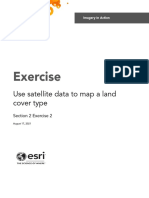Section5 Going3D Transcript
Uploaded by
GeorgeKaramanoglouSection5 Going3D Transcript
Uploaded by
GeorgeKaramanoglouCartography.
MOOC
Section 5
Going 3D
Dr. Kenneth Field, John Nelson and Nathan
Shephard
Dr. Kenneth Field: Hello and welcome to Episode 5 of Cartography, our series of short films
where we're going to discuss aspects of making maps, how to make them a little bit better,
tips and tricks of the trade, and how to become a smarter mapmaker. And joining me for this
episode is --well, frankly, we can't get rid of him -- is John Nelson.
John Nelson: Hello. Welcome back.
Ken: And Nathan Shephard is also joining me. I'm Ken Field, and we're going to get going
with talking about 3D in this episode. Wow. Let's get our cards on the table here. John and I
would occasionally call ourselves cartographers. This gentleman here is ...
Nathan Shephard: Not a cartographer.
Ken: Yeah, okay. So you've joined us for a MOOC on cartography, but 3D is kind of a special
thing. Yeah?
Nathan: Extra special. Extra special.
Ken: I wouldn't go that far.
Nathan: It's important. It has less rules than cartography, which is, I think, why I like it.
John: Ah.
Ken: So I've often called myself a 3D skeptic.
Copyright © 2018 Esri. All rights reserved. 1
Cartography. MOOC
Nathan: You have.
Ken: I sometimes struggle to think why would I make a map in 3D when I can make a pretty
good convincing, compelling map in 2D. So this whole episode is really about you
convincing us, I think.
John: Yeah, likewise. Yeah. I need a lot of convincing when it comes to 3D. "Oh, we should
do this in 3D." And I say, "Why?" And they say, "Because it might look cool."
Ken: It might.
Nathan: Well, it might look cool. You do have to be careful. 3D can be dangerous. It's not for
everybody, and not all maps work out well in 3D. And people will go and look at them.
They're clickbait.
Ken: And that's it. That's all you need to know.
Nathan: That's all you need.
John: Scene. We got it.
Ken: All right. Let's go back then to sort of basics. So we've been talking about a lot of maps
during these episodes and predominantly in two dimensions, planimetric, so just as though
we're looking down on the Earth and dealing with those basic, fundamental principles of
cartography as they apply to a 2D map. So, if we're going to go into the 3D realm, maybe
lead us through one or two things that are fundamentally different and how that makes us
think differently.
Nathan: Yeah, I mean, I think the first thing you need to ask yourself is, "Why am I going to
3D?" Usually, the answer is you're communicating something that doesn't work well in 2D. So
like a building or whatever, a building from above, you can't see anything. If you want to see
it's really high, how tall it is, or you want to see it in conjunction with other buildings, it's really
a good example of where you would go 3D. So then what? Okay, so you go to 3D. You can't
just throw some stuff in and have it look good. You need to think about how everything is
going to fit together. You have to think about continual scale. So I know you map guys, you
Copyright © 2018 Esri. All rights reserved. 2
Cartography. MOOC
love talking about scale. In 3D, you look at something side on, and its continuous scales,
different scales, every one meter along there it's a different scale. So you have to think about
how things are going to work together. You have to think about hiding things off in the
distance, distance-based culling rather than scale-based.
John: Distance-based culling. So by that, you mean what to stop showing at a certain
distance from the eye?
Nathan: Yeah, and it's not just what different stuff to show, but also what level of detail to
show. So I've got this handy cow here. I wasn't planning to use the cow, but now I saw the
cow.
John: Here we go.
Nathan: The cow is in.
John: He's got a bell.
Nathan: Yeah. So like, at a certain distance, this cow looks like a cow. But if you get too close
to it -- I don't know if you could have a closer look at that cow -- you start to see that it's
actually ...
Ken: That's the wrong end of the cow.
Nathan: Well, there we go.
Ken: Thank you.
Nathan: Nice. You can see that it's actually made up of like sculpted faces that don't look like
a cow when you get really close, but from a certain distance, it looks really good. You have to
do that with all of your content. A tree, when you get close to it, you want to see bark. You
want to see some leaves. You might to see some birds in a bird nest maybe, perhaps. But
when you get further away, it can just be a blurry green thing, and that's totally fine. So you
have to think about continuous scale.
Copyright © 2018 Esri. All rights reserved. 3
Cartography. MOOC
Ken: I think that's quite similar to the points of generalization we spoke about in a different
episode, where, at different map scales, you want to see more or less detail.
John: The challenge with 3D is that you're kind of dealing with that all in one go, all in one
view, whereas one of the niceties of a 2D is you have to think about it once per map.
Nathan: When you look outside, things that are far away are smaller, and that's the same
thing in a 3D view. So you might want to use an axonometric.
Ken: Oh, he's pulled out the big words already.
Nathan: I did. I did. Well, isometric, you could also use that perhaps.
John: Well, tell us the difference between isometric and axonometric.
Nathan: I don't want to. They're very similar. They're very similar.
John: Well, one has kind of a forced perspective.
Ken: Isometric is a form of axonometric.
John: And one of them keeps this false sense of even height and just has kind of a two and a
half D effect, right?
Nathan: Are you talking about ... so perspective is where it gets smaller in the distance.
John: Yeah, towards a vanishing point.
Nathan: Yes, that's perspective.
John: Okay.
Nathan: Axonometric or isometric, we kind of use them, the rays are parallel.
John: Okay.
Nathan: So things that are way off in the distance are the same size as if they're close. And it
looks ...
Copyright © 2018 Esri. All rights reserved. 4
Cartography. MOOC
Ken: Scale is equivalent across the whole map.
John: Yeah.
Nathan: Yeah, and it looks good and it doesn't lie. It's really easy to lie with 3D. It's easy to lie
with maps. It's super easy to lie with scenes.
Ken: So my basic kind of principle, if I'm going to go into 3D, is for a natural feature for a
physical map, I'm quite happy with perspective, because it is how we see the landscape. We
look out of an airplane window and we see things moving off. So if you look down, it's kind of
planimetric. And then as you look off into the distance, it becomes more perspective. But for
a thematic, I would perhaps go for the axonometric if I'm in 3D.
Nathan: You might also notice a lot of university campuses have the isometric. It looks kind of
a little bit freaky, but it makes more sense as you wander around it like visually. So, for me, I
think you also need to think about the delivery mechanism. So, with maps, it's a map. You
print it. Here's your map. Have a good time. You have trouble folding it, that kind of stuff. But
with 3D, you might want to ... well, there's a couple different ways of sharing it. One is as a
static image, and that's where axonometric works really well, because you can't get confused
by zooming around and freaking the brain out. So axonometric is good for that. But if you
want to have it exploratory, then you want a 3D scene that people can go around and they
can go wherever they want. That's quite good for realistic scenes where you want to go to a
city.
Ken: I think the context and the medium is important in 3D.
Nathan: Yeah.
Ken: I think you're right, because it overcomes some of the limits. So even if you deal with
something across a curved surface, if you have that ability to interact with the map to turn it
around and see the other side, that overcomes a lot of the historic problems of 3D mapping I
think.
Copyright © 2018 Esri. All rights reserved. 5
Cartography. MOOC
Nathan: Yeah. I mean there's lots of things like that. The hidden content problem is a big
problem with 3D. So let's say I want firehouses in a downtown city and I just put like a little
marker in front of the building for where the fire truck comes out, I wouldn't be able to see
them because all the other buildings get in the way. So I put a giant stick with a billboard on
top, and now we're into 3D cartography. It's a big stick and now I can go around and I can
see where all of the fire stations are and zoom around.
Ken: What I think is fascinating about 3D, certainly from what I've seen, is there was, in the
early days of sort of 3D mapping, a tendency to try and make everything realistic. Let's get it
as realistic as we possibly can. Let's make this look like the real world. Let's invent the real
world in a fake world. I kind of see a trend more towards trying to do that simplification, that
generalization, and that symbolization and to make it more abstract.
Nathan: Yeah.
Ken: Maybe that's to do with the cost. Maybe it's easier to render and cheaper to render and
quicker. But maybe it's also, as in 2D cartography, we want to get it down to its bare,
simplistic facts so it's easy to interpret.
Nathan: Again, just back to the visual variables, if you've got a city and you're seeing all of the
beautiful buildings, but you want to know which ones are in trouble for earthquake-
proofness, you just want to color them red or something. You want to find a way of
communicating. So just like maps communicate, scenes need to communicate too. And when
they do, you want to use thematics a lot more than you want to use realistic.
Ken: And interesting you picked on red there, the use of color to signify danger. So there's a
convergence then on getting the feel for 3D borrowing from some classic cartographies in
2D and then 2D perhaps infiltrating a little bit.
Nathan: I think so. I think a lot of the things that are done in 2D do apply in 3D and should be
reused in 3D.
Copyright © 2018 Esri. All rights reserved. 6
Cartography. MOOC
Ken: And for this episode, we're going to have a map of the week and also a person of the
week, and it's going to be in one single roll ...
John: Rolled all into one amazing package, beautiful.
Ken: Of 3D loveliness.
John: Tactile.
Ken: So, earlier on, you said 3D can be eye candy.
Nathan: Yeah.
Ken: We use a lot of eye candy for tourist mapping to attract people to places and to give
people something really interesting to look at. I'd like to propose Heinrich Berann, the
Austrian, and a lot of his panoramic mapping as something just to think about and to enthuse
people to go to explore.
John: It's something to look up and be amazed.
Nathan: Amazing.
John: Marvel at them.
Ken: I think what's interesting is Heinrich Berann, like a lot of these panoramic artists, wasn't a
cartographer either.
John: What?
Ken: Yeah, I know. These people just infiltrate, you know.
John: The best ones.
Ken: Get away with it. It's great stuff.
Nathan: He's pretty handy with a paintbrush.
Copyright © 2018 Esri. All rights reserved. 7
Cartography. MOOC
Ken: Absolutely. So Berann in the mid-1900s started painting landscapes kind of in aspect.
And if you looked at the combination of a photograph of what he's painting, it looks nothing
like it because he moves mountains. He exaggerates the height of peaks.
John: He'll rotate a mountain to show you the more interesting face.
Ken: And he'll put cloudscapes in there.
John: Amazing cloudscapes.
Ken: They don't exist in reality, but they look absolutely beautiful.
Nathan: Then every now and then, there might be a little building that's so completely the
wrong size, but it just shows you that there's someone there, there's a house there or there's
a lodge there. It looks really cool.
Ken: So I think the map that I'd like to think a little bit about is the Yellowstone map. He did a
series in the early 1960s for the National Park Service in the U.S. of I believe it was four
different national parks. They're just lovely pieces of work that were used to promote the
national park and nothing more. It was just that.
Nathan: Yeah. You look at it, and you just want to go there. You just want to be there. It's
amazing. The colors are so saturated.
Ken: Yeah, a lot of sun glints on the lakes, a little, I think there's a house with a little smoke
stack.
Nathan: Yeah, exactly.
Ken: It's actually wonderful.
Nathan: And the clouds, a nice cloudy day, just enough clouds that it's interesting, but not
too much. It's really nice.
Copyright © 2018 Esri. All rights reserved. 8
Cartography. MOOC
Ken: So I think Heinrich Berann was one of these classic panoramic artists. And I would
encourage people to check out a lot of the work of these other non-cartographers who have
given us these beautiful maps.
Nathan: Yeah. Yeah.
Ken: Yeah.
Ken: Let's see what we've got today. Wow, that's interesting. Look at these.
Nathan: Look at that thing.
Ken: Nathan.
Nathan: Oh, I'll take these.
Ken: Give those a whirl.
Nathan: I'm the only one not wearing glasses already. Oh, yes. Oh, you look so deep.
Ken: Thank you.
Nathan: And full of ...
John: As opposed to his normal ...
Nathan: Shallow.
John: One-dimensional, shallow self.
Nathan: Just need to paint you a bit more green and read.
Ken: You guys just crack me up.
John: We're brutal.
Nathan: So 3D glasses. One side is green and one side's red. Well, it's bluish in this case.
Copyright © 2018 Esri. All rights reserved. 9
Cartography. MOOC
Ken: It's blue.
Nathan: Blue. And what you do is you filter out what's coming into one eye versus the other
eye, and you get some depth perception. It makes things pop out. Probably been to the
movies and used the more modern equivalent with the polarized lenses. You can also get the
shutter ones where they actually ...
John: Flicker?
Nathan: Yeah, they flicker. Yeah, they look after you nicely.
Ken: So the image you're seeing, there's actually two images, right?
Nathan: That's right.
Ken: And they're slightly offset.
Nathan: Yeah.
Ken: And so each eye is seeing a different image, but your brain is putting them together.
John: One direction of that offset versus the other is slightly tinted red or slightly tinted blue?
Ken: For this, for the anaglyph?
Nathan: Yes.
Ken: And the other set that I've used is a chromostereoscopic set, where you've got little
prisms in the glasses, and so they convert color so that you see red very close up and you see
the colors of the rainbow progressively distant. And so you can, in fact, use that to give an
illusion of depth in the map. And actually, there's one behind us. So that red map, back there,
uses chromostereoscopy. So red is near and blue is further back.
Nathan: Nice.
Ken: It's kind of an interesting way of using 3D in an inventive way. What about this?
Copyright © 2018 Esri. All rights reserved. 10
Cartography. MOOC
Nathan: Oh, yeah.
Ken: Hey, that's real 3D, right?
Nathan: There we go. Look at this thing. So this is actually the top of a chocolate box, and it's
the topography of Switzerland. It's got incredible ...
John: What does Switzerland have to do with chocolate, I wonder?
Nathan: Not a thing. I don't know. It's a strange product placement. But they actually have the
topography built in, and you can get the height of the mountains and see how everything
works together. And they've got a regular old 2D map draped over the top so you can see
the names of all of the lakes and the towns. I've actually created a little video where I grabbed
my camera and went really close to the ground along here, so like just miniaturized.
John: Oh, cool.
Nathan: And I tweeted it out, and people thought it was like our software rendering.
Ken: Oh, really?
Nathan: Yeah.
Ken: So I have one final example, which I need to go down here. I'm going to give you those,
first of all.
Nathan: Oh, excellent.
Ken: You can describe what those are.
Nathan: They're green.
John: I know what this is.
Ken: What?
John: I know what this is.
Copyright © 2018 Esri. All rights reserved. 11
Cartography. MOOC
Ken: What?
Nathan: We keep waiting for you to explain it.
John: This is ...
Ken: You actually know something?
John: Yes. Yes.
Ken: Come on.
John: I think I must have caught just the tail end of the lifecycle of these.
Ken: Oh, there we go.
Nathan: There we go.
Ken: So what have we got there, Mr. Nelson?
John: They're wonderful things. They're wonderful things. So what I'm doing is I'm looking
through a couple of lenses at two views of the same geographic location, each photograph
taken from a slightly different angle, perhaps a different pass of a plane angle. And when I
see them at the same time, your mind will force them into a perspective, and you will actually
see raised and lowered elevation dimension. They converge in your mind, and your mind
constructs that 3D environment.
Ken: But this isn't just for kicks. You know, this had a practical purpose of photogrammetry,
plotting contour lines and heights onto topographic maps. So that was a positive box of map
tricks this week.
John: Look I feel great about it having known what it actually was.
Ken: Well, I'm glad we brought one to the table that you actually know something about.
John: Thank you. Thank you.
Copyright © 2018 Esri. All rights reserved. 12
Cartography. MOOC
Ken: And our final piece for today is thinking about some of our pet peeves and cartofails for
3D. One or two we've mentioned already. But Nathan, perhaps you want to kick off with
something that really gets you.
Nathan: I have to let you know that you can't use this word. There is no such word as heighth.
There's no "th" on the end. It's height with just a T.
John: But what if you say it right after width? Is that okay then?
Nathan: Then it's more prevalent. People will say it. You might get a pass once. But if you say
it twice, I'm sorry I ...
John: I suspect you won't give someone a pass.
Nathan: 80% of my workouts is throwing people outside windows from saying heighth. You
can't do that. You should never say heighth. Please.
Ken: Wow. I will be shouting that every time I walk past your office.
Nathan: Yeah. Working out.
Ken: So, John, pet peeve?
John: We kind of mentioned it earlier, but my pet peeve with 3D mapping is seeing
basemaps that are pre-labeled in 2D, which then get draped and stretched out down along
mountain faces and that sort of thing. So reserve labeling for the 3D environment if your
basemap is going to be in 3D.
Nathan: Yeah, especially even if it's like a lake and it's dead flat, you zoom around to the
other side and ...
John: It's upside down.
Nathan: It's upside down. Yeah.
John: It's 3D.
Nathan: Yes.
Copyright © 2018 Esri. All rights reserved. 13
Cartography. MOOC
John: Take advantage of that.
Ken: So 3D thematics for me, a lot of them across a curved surface don't make any sense, and
it bothers me because the whole basis of understanding a thematic map is to compare one
place to another. If you're using the 3D, as we've already mentioned, you've got all that
problem of occlusion and scale complicating, and your brain is just saying, "Oh, look,
everything in the foreground is bigger than everything in the background, and therefore it
must be more important." No, it's just nearer to you. And I guess maybe a final one is back to
this idea of reality versus abstraction.
John: Yeah, I hate that too.
Nathan: If you're going to make a 3D view, please, please don't say heighth and also don't
just try to recreate the real world. Don't look outside your window and say, "I want to make
something like that." Think about how you want to communicate. What are you trying to tell
people? You're making something to communicate a message and some information. Use
cartographic techniques in 3D. You'll love it.
Ken: So you're starting to sound like a cartographer.
Nathan: I don't know.
Ken: Well, yeah.
Nathan: I'm reluctant. You need to convince me. Maybe we can start there.
Ken: Well, you're starting to sound like one.
Nathan: There we go.
Ken: So I think that brings us to the end of this episode. We had some fun with 3D. Use 3D
with caution. It can be great. Yeah?
John: Look at this 3D biscuit we have here.
Ken: It's biscuit time.
Copyright © 2018 Esri. All rights reserved. 14
Cartography. MOOC
Nathan: Oh, it's biscuit time.
Ken: Yeah.
John: Help yourself.
Ken: Help yourself to a biscuit.
John: There's no wrong choice.
Nathan: There's no wrong choice? Well, you always take the roof. That's the rule. Thank you
very much.
John: We raised the roof.
Ken: All right. Thanks to you. Thank you.
Copyright © 2018 Esri. All rights reserved. 15
You might also like
- Hourglass Workout Program by Luisagiuliet 276% (21)Hourglass Workout Program by Luisagiuliet 251 pages
- The Hold Me Tight Workbook - Dr. Sue Johnson100% (16)The Hold Me Tight Workbook - Dr. Sue Johnson187 pages
- Read People Like A Book by Patrick King-Edited62% (66)Read People Like A Book by Patrick King-Edited12 pages
- Livingood, Blake - Livingood Daily Your 21-Day Guide To Experience Real Health77% (13)Livingood, Blake - Livingood Daily Your 21-Day Guide To Experience Real Health260 pages
- COSMIC CONSCIOUSNESS OF HUMANITY - PROBLEMS OF NEW COSMOGONY (V.P.Kaznacheev,. Л. V. Trofimov.)94% (212)COSMIC CONSCIOUSNESS OF HUMANITY - PROBLEMS OF NEW COSMOGONY (V.P.Kaznacheev,. Л. V. Trofimov.)212 pages
- Donald Trump & Jeffrey Epstein Rape Lawsuit and Affidavits83% (1016)Donald Trump & Jeffrey Epstein Rape Lawsuit and Affidavits13 pages
- The 36 Questions That Lead To Love - The New York Times94% (34)The 36 Questions That Lead To Love - The New York Times3 pages
- The 36 Questions That Lead To Love - The New York Times95% (21)The 36 Questions That Lead To Love - The New York Times3 pages
- Jeffrey Epstein39s Little Black Book Unredacted PDF75% (12)Jeffrey Epstein39s Little Black Book Unredacted PDF95 pages
- John, Jr. Collier, Malcolm Collier - Visual Anthropology - Photography As A Research MethodNo ratings yetJohn, Jr. Collier, Malcolm Collier - Visual Anthropology - Photography As A Research Method477 pages
- The 4 Hour Workweek, Expanded and Updated by Timothy Ferriss - Excerpt23% (954)The 4 Hour Workweek, Expanded and Updated by Timothy Ferriss - Excerpt38 pages
- Exercise: Create A 2D Animation Through TimeNo ratings yetExercise: Create A 2D Animation Through Time28 pages
- Section1Exercise2 AccessingArcGISForThisCourse PDFNo ratings yetSection1Exercise2 AccessingArcGISForThisCourse PDF10 pages
- Exercise: Prepare Training Sample Data For Object DetectionNo ratings yetExercise: Prepare Training Sample Data For Object Detection12 pages
- Section6 MappingMovementandChange TranscriptNo ratings yetSection6 MappingMovementandChange Transcript15 pages
- Exercise: Create A 2D Animation Through TimeNo ratings yetExercise: Create A 2D Animation Through Time28 pages
- ArcGIS Photoshop Painted Relief MethodologyNo ratings yetArcGIS Photoshop Painted Relief Methodology6 pages
- Section3Exercise1 ScaleAndGeneralizationNo ratings yetSection3Exercise1 ScaleAndGeneralization33 pages
- Exercise: Create A Stop-Motion AnimationNo ratings yetExercise: Create A Stop-Motion Animation26 pages
- Spatial Data Science MOOC Section 6 Exercise 2 - Communicate Your Analysis Using ArcGIS StoryMapsNo ratings yetSpatial Data Science MOOC Section 6 Exercise 2 - Communicate Your Analysis Using ArcGIS StoryMaps16 pages
- Statistical Methods For Spatial Data AnalysisNo ratings yetStatistical Methods For Spatial Data Analysis164 pages
- Beyond Mapping Extend The Role of Cartographers To User Interface Designers in The Metaverse Using Virtual Reality Augmented Reality and Mixed RealNo ratings yetBeyond Mapping Extend The Role of Cartographers To User Interface Designers in The Metaverse Using Virtual Reality Augmented Reality and Mixed Real16 pages
- Spatialdataanalysis1 140323115706 Phpapp01No ratings yetSpatialdataanalysis1 140323115706 Phpapp01102 pages
- Section2 Exercise1 Create A Prediction ModelNo ratings yetSection2 Exercise1 Create A Prediction Model36 pages
- Getting Started with CNC Personal Digital Fabrication with Shapeoko and Other Computer Controlled Routers 1st Edition Ford - Own the complete ebook set now in PDF and DOCX formats100% (1)Getting Started with CNC Personal Digital Fabrication with Shapeoko and Other Computer Controlled Routers 1st Edition Ford - Own the complete ebook set now in PDF and DOCX formats47 pages
- Exercise 5 - Spatial Analysis and Model Builder100% (1)Exercise 5 - Spatial Analysis and Model Builder50 pages
- Exercise: Geography Matters: Analyzing DemographicsNo ratings yetExercise: Geography Matters: Analyzing Demographics28 pages
- Kent, Brian R - 3D Scientific Visualization With BlenderNo ratings yetKent, Brian R - 3D Scientific Visualization With Blender91 pages
- Section6Exercise1 MakingPredictions ParticulateMatterExposure PDFNo ratings yetSection6Exercise1 MakingPredictions ParticulateMatterExposure PDF66 pages
- Geodatabase Topology Rules and Topology Error FixeNo ratings yetGeodatabase Topology Rules and Topology Error Fixe29 pages
- Section1 Exercise3 CreateAndExportAMapLayoutForPrintNo ratings yetSection1 Exercise3 CreateAndExportAMapLayoutForPrint21 pages
- Exercise: Create A Fly-Through AnimationNo ratings yetExercise: Create A Fly-Through Animation22 pages
- Section2Exercise2 Agriculture ArcGISProNo ratings yetSection2Exercise2 Agriculture ArcGISPro43 pages
- Exercise: Getting Started With Arcgis ProNo ratings yetExercise: Getting Started With Arcgis Pro8 pages
- Use ArcGIS Dashboards To Share Imagery ResultsNo ratings yetUse ArcGIS Dashboards To Share Imagery Results12 pages
- Section2Exercise1 WorkingWithMapProjectionsNo ratings yetSection2Exercise1 WorkingWithMapProjections14 pages
- Exercise: Explore Data Using Data Visualization TechniquesNo ratings yetExercise: Explore Data Using Data Visualization Techniques41 pages
- Exercise: Use Imagery To Locate Areas of InterestNo ratings yetExercise: Use Imagery To Locate Areas of Interest27 pages
- Blender Relief Tutorial - Getting Set UpNo ratings yetBlender Relief Tutorial - Getting Set Up9 pages
- Download GIS for Environmental Decision Making 1st Edition Andrew A. Lovett (Editor) ebook All Chapters PDF100% (1)Download GIS for Environmental Decision Making 1st Edition Andrew A. Lovett (Editor) ebook All Chapters PDF53 pages
- 127x Reclassify Color Gradient domlyszBlenderGIS Wiki GitHubNo ratings yet127x Reclassify Color Gradient domlyszBlenderGIS Wiki GitHub12 pages
- Exercise: Access Satellite Data in Arcgis ProNo ratings yetExercise: Access Satellite Data in Arcgis Pro21 pages
- Photo Reality Capture For Preliminary Infrastructure Design WebNo ratings yetPhoto Reality Capture For Preliminary Infrastructure Design Web16 pages
- Exercise: Use Satellite Data To Map A Land Cover TypeNo ratings yetExercise: Use Satellite Data To Map A Land Cover Type22 pages
- Spatial Data Science MOOC Section 4 Exercise 1 - Detect PatternsNo ratings yetSpatial Data Science MOOC Section 4 Exercise 1 - Detect Patterns11 pages
- Section3Exercise2 EnvironmentalMgmt ArcGISProNo ratings yetSection3Exercise2 EnvironmentalMgmt ArcGISPro44 pages
- Section1 Exercise1 PerformDataEngineeringTasksNo ratings yetSection1 Exercise1 PerformDataEngineeringTasks30 pages
- Section1 Exercise1 Perform Data Engineering TasksNo ratings yetSection1 Exercise1 Perform Data Engineering Tasks18 pages
- Lesson 2: Organic Forms, Dissections and Form Intersections: Thinking in 3DNo ratings yetLesson 2: Organic Forms, Dissections and Form Intersections: Thinking in 3D74 pages
- Lesson 2: Organic Forms, Dissections and Form Intersections: Thinking in 3DNo ratings yetLesson 2: Organic Forms, Dissections and Form Intersections: Thinking in 3D74 pages
- Assignment Optical Inst Interference Comp PhysNo ratings yetAssignment Optical Inst Interference Comp Phys18 pages
- The League of Unexceptional Children (Preview)100% (1)The League of Unexceptional Children (Preview)26 pages
- Biology: University of Cambridge International Examinations General Certificate of Education Ordinary LevelNo ratings yetBiology: University of Cambridge International Examinations General Certificate of Education Ordinary Level12 pages
- How I Become A Cover Model-BodyDoctor HDNo ratings yetHow I Become A Cover Model-BodyDoctor HD2 pages
- 1 Composite Beam Theory: Developed by Scott Civjan University of Massachusetts, AmherstNo ratings yet1 Composite Beam Theory: Developed by Scott Civjan University of Massachusetts, Amherst27 pages
- The Tempest (Unproduced Script by D Nichols & J Renoir)No ratings yetThe Tempest (Unproduced Script by D Nichols & J Renoir)93 pages
- Manners of Representing Subjects and Kinds of Subject100% (1)Manners of Representing Subjects and Kinds of Subject61 pages
- OPENCV - Topic 04 - Histogram Specification100% (1)OPENCV - Topic 04 - Histogram Specification5 pages
- Livingood, Blake - Livingood Daily Your 21-Day Guide To Experience Real HealthLivingood, Blake - Livingood Daily Your 21-Day Guide To Experience Real Health
- COSMIC CONSCIOUSNESS OF HUMANITY - PROBLEMS OF NEW COSMOGONY (V.P.Kaznacheev,. Л. V. Trofimov.)COSMIC CONSCIOUSNESS OF HUMANITY - PROBLEMS OF NEW COSMOGONY (V.P.Kaznacheev,. Л. V. Trofimov.)
- Donald Trump & Jeffrey Epstein Rape Lawsuit and AffidavitsDonald Trump & Jeffrey Epstein Rape Lawsuit and Affidavits
- The 36 Questions That Lead To Love - The New York TimesThe 36 Questions That Lead To Love - The New York Times
- The 36 Questions That Lead To Love - The New York TimesThe 36 Questions That Lead To Love - The New York Times
- Jeffrey Epstein39s Little Black Book Unredacted PDFJeffrey Epstein39s Little Black Book Unredacted PDF
- John, Jr. Collier, Malcolm Collier - Visual Anthropology - Photography As A Research MethodJohn, Jr. Collier, Malcolm Collier - Visual Anthropology - Photography As A Research Method
- The 4 Hour Workweek, Expanded and Updated by Timothy Ferriss - ExcerptThe 4 Hour Workweek, Expanded and Updated by Timothy Ferriss - Excerpt
- Section1Exercise2 AccessingArcGISForThisCourse PDFSection1Exercise2 AccessingArcGISForThisCourse PDF
- Exercise: Prepare Training Sample Data For Object DetectionExercise: Prepare Training Sample Data For Object Detection
- Spatial Data Science MOOC Section 6 Exercise 2 - Communicate Your Analysis Using ArcGIS StoryMapsSpatial Data Science MOOC Section 6 Exercise 2 - Communicate Your Analysis Using ArcGIS StoryMaps
- Beyond Mapping Extend The Role of Cartographers To User Interface Designers in The Metaverse Using Virtual Reality Augmented Reality and Mixed RealBeyond Mapping Extend The Role of Cartographers To User Interface Designers in The Metaverse Using Virtual Reality Augmented Reality and Mixed Real
- Getting Started with CNC Personal Digital Fabrication with Shapeoko and Other Computer Controlled Routers 1st Edition Ford - Own the complete ebook set now in PDF and DOCX formatsGetting Started with CNC Personal Digital Fabrication with Shapeoko and Other Computer Controlled Routers 1st Edition Ford - Own the complete ebook set now in PDF and DOCX formats
- Exercise: Geography Matters: Analyzing DemographicsExercise: Geography Matters: Analyzing Demographics
- Kent, Brian R - 3D Scientific Visualization With BlenderKent, Brian R - 3D Scientific Visualization With Blender
- Section6Exercise1 MakingPredictions ParticulateMatterExposure PDFSection6Exercise1 MakingPredictions ParticulateMatterExposure PDF
- Geodatabase Topology Rules and Topology Error FixeGeodatabase Topology Rules and Topology Error Fixe
- Section1 Exercise3 CreateAndExportAMapLayoutForPrintSection1 Exercise3 CreateAndExportAMapLayoutForPrint
- Exercise: Explore Data Using Data Visualization TechniquesExercise: Explore Data Using Data Visualization Techniques
- Download GIS for Environmental Decision Making 1st Edition Andrew A. Lovett (Editor) ebook All Chapters PDFDownload GIS for Environmental Decision Making 1st Edition Andrew A. Lovett (Editor) ebook All Chapters PDF
- 127x Reclassify Color Gradient domlyszBlenderGIS Wiki GitHub127x Reclassify Color Gradient domlyszBlenderGIS Wiki GitHub
- Photo Reality Capture For Preliminary Infrastructure Design WebPhoto Reality Capture For Preliminary Infrastructure Design Web
- Exercise: Use Satellite Data To Map A Land Cover TypeExercise: Use Satellite Data To Map A Land Cover Type
- Spatial Data Science MOOC Section 4 Exercise 1 - Detect PatternsSpatial Data Science MOOC Section 4 Exercise 1 - Detect Patterns
- Lesson 2: Organic Forms, Dissections and Form Intersections: Thinking in 3DLesson 2: Organic Forms, Dissections and Form Intersections: Thinking in 3D
- Lesson 2: Organic Forms, Dissections and Form Intersections: Thinking in 3DLesson 2: Organic Forms, Dissections and Form Intersections: Thinking in 3D
- Biology: University of Cambridge International Examinations General Certificate of Education Ordinary LevelBiology: University of Cambridge International Examinations General Certificate of Education Ordinary Level
- 1 Composite Beam Theory: Developed by Scott Civjan University of Massachusetts, Amherst1 Composite Beam Theory: Developed by Scott Civjan University of Massachusetts, Amherst
- The Tempest (Unproduced Script by D Nichols & J Renoir)The Tempest (Unproduced Script by D Nichols & J Renoir)
- Manners of Representing Subjects and Kinds of SubjectManners of Representing Subjects and Kinds of Subject























































































































